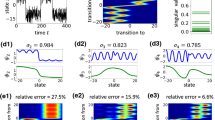Summary
A Bayesian approach to nonstationary process analysis is proposed. Given a set of data, it is divided into several blocks with the same length, and in each block an autoregressive model is fitted to the data. A constraint on the autoregressive coefficients of the successive blocks is considered. This constraint controls the smoothness of the temporal change of spectrum as shown in Section 2. A smoothness parameter, which is called a hyper parameter in this article, is determined with the aid of the minimum ABIC (Akaike Bayesian Information Criterion) procedure. Numerical examples of our procedure are also given.
Similar content being viewed by others
References
Akaike, H. (1979). On the construction of composite time series model,Bull. 42nd Session I.S.I.,48, 411–422.
Akaike, H. (1980). Likelihood and the Bayes procedure, Bayesian Statistics (eds. Bernardo, J. S., Degroot, M. H. Lindley, D. V. and Smith, A. F. M.).
Akaike, H. et al. (1985). TIMSAC-84 (A Time Series Analysis and Control Program Package),Computer Science Monographs,22, The Institute of Statistical Mathematics, Tokyo.
Bendat, J. S. and Piersol, A. G. (1966).Measurement and Analysis of Random Data, John Wiley & Sons, New York.
Hino, M. (1977).Spectral Analysis, Asakura Shoten, Tokyo (in Japanese).
Kitagawa, G. and Akaike, H. (1978). A procedure for the modeling of non-stationary time series,Ann. Inst. Statist. Math.,30, 351–363.
Kitagawa, G. and Akaike, H. (1981).On TIMSAC-78,Applied Time Series Analysis II (ed. Findley, D.), 449–548. Academic Press, New York.
Kitagawa, G. (1983). Changing spectrum estimation,J. Sound and Vib.,89, 433–445.
Mark, W. D. (1970). Spectral analysis of the convolution and filtering of non-stationary stochastic processes,J. Sound and Vib.,11, 19–63.
Ozaki, T. and Tong, H. (1975). On the fitting of non-stationary autogressive models in time series analysis,Proceeding of 8th Hawaii International Conference on System Sciences, 224–226.
Page, C. H. (1952). Instantaneous power spectra,J. Appl. Phys.,23, 103–106.
Priestley, M. B. (1965). Evolutionary spectra and non-stationary processes,J. R. Statist. Soc., B27, 221–224.
Priestley, M. B. (1967). Power spectral analysis of non-stationary random processes,J. Sound and Vib.,6, 86–97.
Subba Rao, T. (1970). The fitting of non-stationary time-series model with time-dependent parameters,J. R. Statist. Soc., B32, 312–332.
Additional information
The Institute of Statistical Mathematics
About this article
Cite this article
Tamura, YH. An approach to the nonstationary process analysis. Ann Inst Stat Math 39, 227–241 (1987). https://doi.org/10.1007/BF02491462
Received:
Revised:
Published:
Issue Date:
DOI: https://doi.org/10.1007/BF02491462




